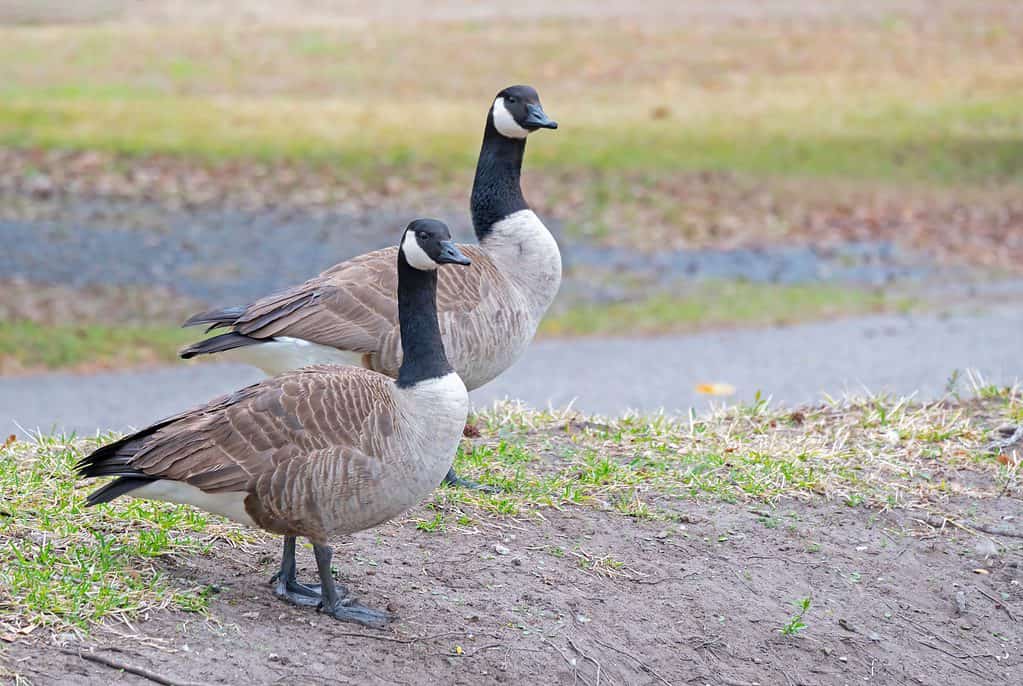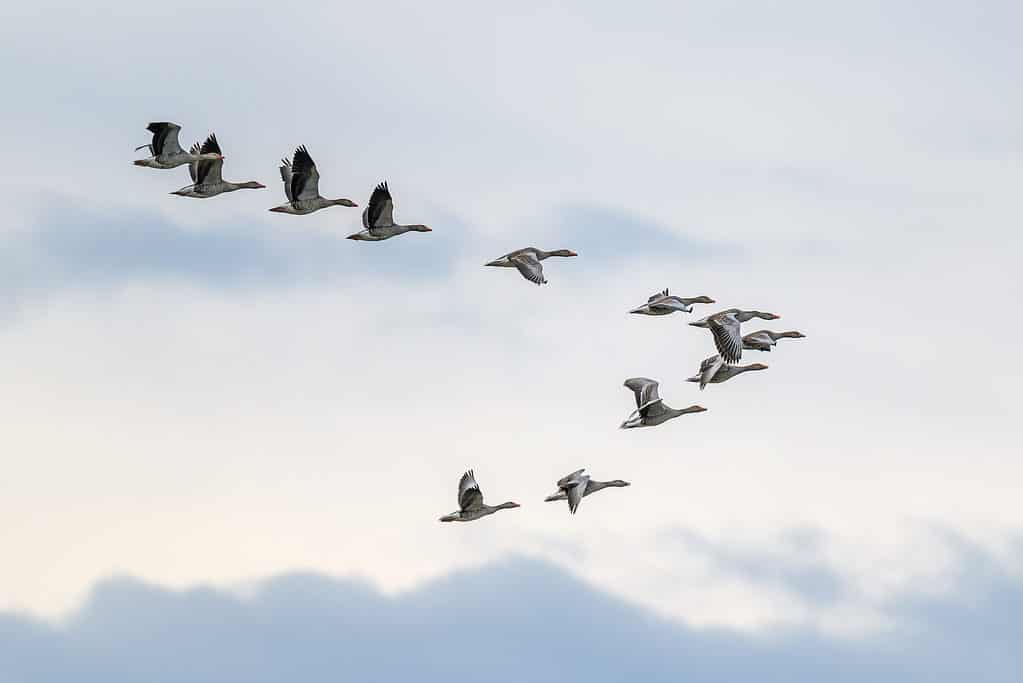No doubt at some point in your life, you’ve seen a gaggle of geese flying overhead in their distinctive “V-shaped” formation. Perhaps they were migrating south for the winter, or north in the spring. But do you know basic details, like why they migrate or why they fly in a “V”? Are you aware of where they come from and where they go? It’s an interesting story. Let’s dive in!
Description of Geese

Geese nest on the ground and, like other birds, their young hatch from eggs.
©Daniel Wright98/Shutterstock.com
Types of Geese
Geese are a type of waterfowl that belong to the family Anatidae, which also includes ducks and swans. There are about 29 different species of geese, including Canadian geese, snow geese, and Brant geese. They vary in size, color, and habitat preference.
Appearance
These birds are distinguished by their long necks, webbed feet, and distinctive “honking” and “hissing” vocalizations. They can grow to 23-50 inches long with a wingspan of 4.2-6.1 feet. Their feathers are typically brown, grey, black, or white. They are excellent swimmers and long-endurance fliers, achieving flight speeds of up to 55 mph. And they cover as much as 1,500 miles of flight distance in just 24 hours!
Family Life
Geese nest on the ground and, like other birds, their young hatch from eggs. The average clutch size is five eggs. Geese are omnivores, consuming plant matter, insects, grubs, and small fish or tadpoles when they can catch them. They form strong family bonds, so many of the migratory formations you see flying overhead consist of family groups. These birds have relatively long lifespans, living from 12-26 years.
Geese as Game Birds
Some species are protected, while others can be hunted in the proper season by sportsmen with a hunting license. By all accounts, goose meat is something of an acquired taste. It is all dark meat, and some describe it as rich and savory. They say it is “more flavorful than chicken, and closer in taste to roast beef.” Others say that it can be stringy, tough, and gamey. Some of these differences come down to whether the bird was raised domestically or hunted in the wild.
Habitats of Geese

Geese can be highly territorial and aggressive during nesting season.
©Bildagentur Zoonar GmbH/Shutterstock.com
Geese live in freshwater and saltwater habitats. They like to nest and breed near rivers, ponds, marshes, and coastal areas. They are a species that has adapted well to living alongside people. It’s not unusual to see geese in artificial ponds in parks or on golf courses. Humans keep down the population of coyotes and other natural predators, and people themselves don’t hunt and eat geese in urban areas, so there’s a great advantage to these birds to live near large concentrations of people.
Downsides of Geese
There are downsides to geese living around humans. They are noisy and can be aggressive toward people walking in the park near water features. They leave droppings all over the grass and walkways, which of course is smelly, unhygienic, and unpleasant for walkers and runners. Flying geese are extremely dangerous to aircraft, as they can get pulled into the engines and cause a crash.
Institutions and citizens who want to keep geese away sometimes enforce bans on feeding them. It’s also possible to cover smaller ponds in winter to discourage them from stopping there. Sometimes chemical repellants or noisemakers are used to scare them off. Finally, they can be caught and relocated . . . though there’s certainly no guarantee they won’t come back.
What Geese Do in Winter

Geese fly in a V formation to take advantage of air currents created by their wings.
©Volodymyr Burdiak/Shutterstock.com
Goose Migration
Geese are migratory birds. Some species migrate very long distances, such as Canada geese. This species spends the summer in the Arctic islands of Canada, then migrates 2-3,000 miles to Mexico for the winter! Central European geese migrate to Spain and North Africa. Central Asian geese fly to India and Pakistan in the winter.
Navigation Strategies
How do geese navigate such long distances? Biologists think they use a variety of means. The position of the sun and bright stars, Earth’s magnetic field, and familiar landmarks on the ground might all be part of their navigational system. Because they migrate as groups, they also learn the migratory route from older generations. You may have noticed that geese fly in a “V-shape.” This helps them conserve energy. The leading bird has to cut through the most wind resistance. The ones behind it fly in the slipstream to conserve energy. This technique is also used by competitive bicyclists. Geese take turns in the lead position to give each other a chance to rest.
Winter Activities
Once they arrive at their winter home, geese spend most of their time fattening up, eating grasses, grains, and anything else their hearts desire and their stomachs can digest. In spring, they start the long journey back north, drawing on the fat reserves they built up from a winter of feasting.
Should You Feed Geese?

Feeding geese can lead to a population explosion.
©WoodysPhotos/iStock via Getty Images
Many kind-hearted people want to feed geese in public parks or private ponds. They either want to have a closer encounter with them or they feel sorry for them and want to help them survive. However, there are many good reasons not to do it:
- It makes them less cautious around people. This can lead to negative interactions.
- Bread and other human food fill birds up but don’t have much nutritional value, and they increase defecation. If they load up on this “junk food,” they can become malnourished and sickly.
- Feeding geese can attract more, making them a greater nuisance. This in turn will lead to more complaints and pressure to cull these birds.
- A high-carbohydrate diet causes geese to defecate more. Not only are their droppings smelly and unsightly, but they attract flies and other insects and can spread disease.
- Overfed geese will leave unwanted bread on the ground where it attracts vermin, gets moldy, and can spread avian lung infections.
- Uneaten bread in the water encourages the growth of algae, disturbing the ecological balance for fish and other aquatic species.
Where To See Wild Geese
You can visit a zoo to see exotic species of geese or stop by a farm to see domestic ones. But if you want to observe them in the wild, some popular locations include:
- Wildlife refuges
- Coastal areas
- Parks, golf courses, residential ponds
- Agricultural fields
Check with local birding groups or local Audubon Societies for specific locations near you to go go goose-watching.
The photo featured at the top of this post is © iStock.com/bilbowden
Thank you for reading! Have some feedback for us? Contact the AZ Animals editorial team.






